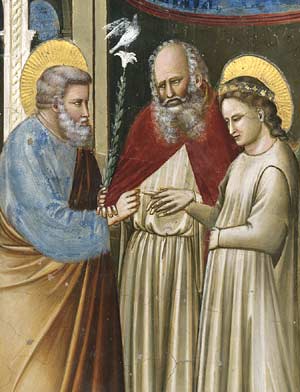
 |
| Detail showing Mary's betrothal to the elderly Joseph |
The six scenes of the
infancy and marriage of the Virgin are placed in the upper register opposite
the scenes of Joachim and Anna on the facing wall. A series of echoes
is thus set up, continually inviting the spectator to read one wall and
then the other.
Giotto places the annunciant Archangel and Mary on either side of the
chancel arch, creating a link between the side walls. The great prominence
of the two figures - emphasised by their being placed in symmetrically
matching foreshortened architectural settings - is probably an allusion
to the Marian mystery plays which were staged in the square in front of
the Chapel: one of the episodes performed was the Annunciation, commemorating
the feast day on which the Chapel was dedicated.
Above Gabriel and the Virgin, a festive choir of angels flanks God the
Father, seated on a throne depicted in perspective. The figure of God
is painted on a wooden panel set into the wall, a technical peculiarity
which suggests the former existence of a window, walled up at an early
stage so as not to disturb the continuity of the painting.
Sources
Here again, the episodes do not figure in the canonical Gospels. Their
literary sources are the Protevangelium of James (particularly chapters
IX and X) and the Golden Legend, which celebrates the feast of the Birth
of the Virgin on 8 September. Jacopo da Varagine defines this feast as
a 'rebirth through penitence', in memory of Joachim's humiliation. The
scenes which begin the two sequences (the Expulsion of Joachim and the
Birth of the Virgin are accordingly united by strong symbolic ties; and
in this context the way the Temple from which Joachim is expelled finds
an echo (though seen from another angle) in the one which the child Mary
enters, can be read as a form of 'compensation'.
Other, less important, literary sources may be the Apocryphal Gospel of
Pseudo-Matthew and Gospel of the Birth of the Virgin, both largely incorporated
in the Golden Legend.
The last scene on this wall is difficult to understand, and a correct
reading is further complicated by its poor state of preservation. According
to some scholars, it is a literal illustration of a passage from the Protevangelium
of James (included in condensed form in the Golden Legend) which describes
Mary's return to her parents, accompanied by seven girls and a few musicians;
for others, it represents Mary and Joseph's wedding procession, as they
make their way to their house in Nazareth.
In any case, the episode immediately precedes the Annunciation.
Iconography
When it comes to visual sources, the small group of women round the bed
in which Anna gives birth to Mary have been compared to the panels of
the pulpits in Pisa and Siena sculpted by Nicola and Giovanni Pisano,
while in the last scene on the wall, usually called the Wedding Procession,
there are echoes of the elongated forms of French Gothic sculpture.
From an iconographic point of view, an unusual amount of attention is
given to the betrothal of Mary and Joseph, which follows the Birth and
Presentation of the Virgin and occupies four panels - three of them figuring
a great apse representing the inside of the Temple. It is not impossible
that Giotto expanded the story merely so as to have the same number of
scenes as for Joachim and Anna, but whatever the reason the emphasis is
very odd. Giotto even deliberately adds an episode not in his literary
sources - this is the intense and mystical prayer by the priest and the
suitors for the Virgin's hand, all kneeling in front of the altar on which
the rods are placed. The reluctant posture of the no-longer youthful Joseph
is extremely close in spirit to the Golden Legend, where he is always
modest and withdrawn.